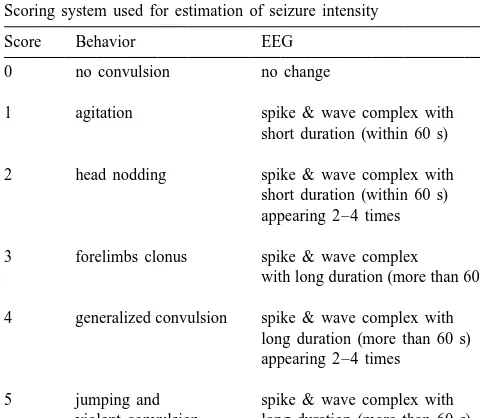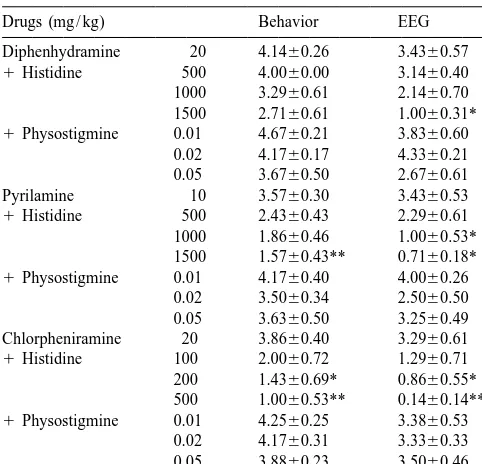Brain Research 887 (2000) 183–186
www.elsevier.com / locate / bres
Short communication
Mechanism responsible for epileptogenic activity by first-generation
H1-antagonists in rats
*
Chiaki Kamei , Masaya Ohuchi, Yukio Sugimoto, Chihiro Okuma
Department of Pharmacology, Faculty of Pharmaceutical Sciences, Okayama University, Okayama 700-8530, Japan
Accepted 26 September 2000
Abstract
In the present study, we have demonstrated that multiple first-generation H1-antagonists caused behavioral and EEG seizures in rats. The epileptogenic property of pyrilamine was more potent than either chlorpheniramine or diphenhydramine. In contrast, the second-generation H1-antagonists, loratadine and ebastine did not induce detectable epileptogenic activity. Intraperitoneal injection of histidine inhibited the EEG seizures induced by pyrilamine, diphenhydramine or chlorpheniramine; however no antagonism was observed with physostigmine. These results clearly suggest that the epileptogenic activity of first-generation H1-antagonists is dependent upon a centrally acting histaminergic mechanism. 2000 Elsevier Science B.V. All rights reserved.
Theme: Disorders of the nervous system
Topic: Epilepsy: brain mechanisms
Keywords: Epileptogenic activity; Diphenhydramine; Pyrilamine; Chlorpheniramine; Histidine; Physostigmine
First-generation H1-antagonists, such as diphenhydra- examined the mechanism responsible for the generation of mine and chlorpheniramine, induce diminished alertness, epileptogenic activity by the first-generation H1-antago-slowed reaction time and somnolence [3]. In animal nists using histidine and physostigmine.
models, these drugs also cause decreased locomotor activi- Seven to eight-week-old male Wistar strain rats (Nippon ty [12], inhibition of active avoidance responses [6], SLC, Shizuoka, Japan), weighing 200–250 g, were main-inhibition of climbing tests [9], and potentiation of tained in an air-conditioned room controlled for tempera-thiopental-induced sleep [12]. In addition, first-generation ture (24628C) and humidity (55615%). Animals were H1-antagonists increase the EEG power spectra of the given food and water ad libitum. Under pentobarbital
delta and theta bands, indicating that these drugs cause anesthesia (35 mg / kg i.p., Nembutal , Abbott Laborator-sedative and EEG slowing effects [7,10]. However, high ies, North Chicago, IL, USA), bipolar electrodes were doses of diphenhydramine, promethazine and pyrilamine, implanted into the right frontal cortex (A: 6.9, L: 3.0) produced convulsions in epileptic patients and young according to the atlas of de Groot [4] after the animals children [15]. In animal studies, Scherkl et al. [11] reported were fixed to a stereotaxic apparatus. Cortical electrodes, that treatment with dimethindene and promethazine de- made of stainless steel screws (1.0 mm in diameter and 1.5 creases electrically-induced maximal seizure thresholds. mm in length), were inserted into the skull over the motor Recently, Yokoyama et al. [14] demonstrated that centrally area. Electrodes were connected to a miniature receptacle, acting H1-antagonists promote the development of which was embedded into the skull with dental cement amygdala kindling in rats. The present study was under- [13]. Post-surgical recovery time was a minimun of 2 taken to clarify the epileptogenic activity of first-gene- weeks.
ration H1-antagonists delivered intravenously in rats. We Behavioral seizures and EEG changes (Fig. 1) induced by the drugs were estimated by the scoring system shown in Table 1. Diphenhydramine hydrochloride (Sigma, St. *Corresponding author. Tel.: 181-86-251-7939; fax:
181-86-251-Louis, MO, USA), pyrilamine maleate (Sigma), d-chlor-7939.
E-mail address: [email protected] (C. Kamei). pheniramine maleate (Sigma), loratadine (Janssen Kyowa,
184 C. Kamei et al. / Brain Research 887 (2000) 183 –186
Fig. 1. Example of EEG seizure induced by H1 antagonists. (a) Control; (b) spike & wave complex with short duration (within 60 s) score 1 in Table 1; (c) spike & wave complex with long duration (more than 60 s) score 3 in Table 1.
Tokyo, Japan), ebastine (Dainippon, Osaka, Japan), L- intravenous injection of H1-antagonists. Diphenhydramine
histidine hydrochloride monohydrate (Wako, Osaka, Japan) caused convulsive behavior in a dose–dependent manner at and physostigmine (Sigma) were used in these studies. doses of 10 and 20 mg / kg. Spiking activity on the EEG H1-antagonists were injected intravenously. Histidine and was observed after treatment with diphenhydramine at a physostigmine were injected intraperitoneally. All pro- dose of 20 mg / kg. Pyrilamine induced significant convul-cedures involving animals were conducted in accordance sive behavior and EEG seizure at doses of 10 and 20 with the guidelines of the Animal Care and Use Commit- mg / kg. Chlorpheniramine also elicited significant epilep-tee, Faculty of Pharmaceutical Sciences, Okayama Uni- togenic activity at a dose of 20 mg / kg: both convulsive versity. The data are expressed as a mean6S.E.M. The behavior and EEG seizure were observed. The second-ANOVA and Kruskal–Wallis tests were used for assessing generation H1-antagonists, loratadine and ebastine, did not significant effects on both behavioral and EEG seizures. induce convulsive behavior and EEG seizure even at a Table 2 shows the epileptogenic activity induced by dose of 20 mg / kg. Table 3 shows the effects of histidine and physostigmine on epileptogenic activity induced by intravenous injection of first-generation H1-antagonists. Table 1
Histidine (1,500 mg / kg, i.p.) antagonized the convulsive Scoring system used for estimation of seizure intensity
behavior and EEG seizure induced by diphenhydramine
Score Behavior EEG
0 no convulsion no change Table 2
Epileptogenic activity induced by intravenous injection of certain
H1-a
1 agitation spike & wave complex with antagonists short duration (within 60 s)
Drugs (mg / kg) Behavior EEG
2 head nodding spike & wave complex with Saline – 0.0060.00 0.0060.00 short duration (within 60 s) Diphenhydramine 5 0.2560.16 0.0060.00
appearing 2–4 times 10 0.8860.13* 0.2560.16
20 4.2560.25** 3.1360.58** 3 forelimbs clonus spike & wave complex Pyrilamine 5 0.1360.13 0.0060.00
with long duration (more than 60 s) 10 3.1560.16** 3.5060.46** 20 4.6360.18** 4.6360.26** 4 generalized convulsion spike & wave complex with Chlorpheniramine 5 0.0060.00 0.0060.00
long duration (more than 60 s) 10 0.7560.25 0.1360.12
appearing 2–4 times 20 3.8860.35** 3.3860.53**
Loratadine 20 0.0060.00 0.0060.00 5 jumping and spike & wave complex with Ebastine 20 0.0060.00 0.0060.00
violent convulsion long duration (more than 60 s) a
Each value represents the mean S.E.M. of 7–8 rats. appearing more than 5 times
C. Kamei et al. / Brain Research 887 (2000) 183 –186 185
Table 3 In addition, although both compounds have potent
Effects of histidine and physostigmine on epileptogenic activity induced peripheral antihistaminic activity [1,13], they only slightly
a
by intravenous injection of first-generation H1-antagonists 3
inhibit the specific binding of H-pyrilamine in guinea pig Drugs (mg / kg) Behavior EEG cortex in vitro [1,2]. There are many reports that histamine
Diphenhydramine 20 4.1460.26 3.4360.57 has an anticonvulsant effect acting through H1 receptors. 1Histidine 500 4.0060.00 3.1460.40 For example, histamine inhibits electroshock seizures in 1000 3.2960.61 2.1460.70 mice [15] and kindling effects in rats [5]. In addition, Haas 1500 2.7160.61 1.0060.31*
and Woef reported that histamine acts on neurons in the rat 1Physostigmine 0.01 4.6760.21 3.8360.60
cerebral cortex [16]. In the present study, we demonstrate 0.02 4.1760.17 4.3360.21
0.05 3.6760.50 2.6760.61 that the epileptogenic activity by first-generation H1-an-Pyrilamine 10 3.5760.30 3.4360.53 tagonists is inhibited by histidine, but not by physostig-1Histidine 500 2.4360.43 2.2960.61 mine. These results suggest that the induction of
epi-1000 1.8660.46 1.0060.53*
leptogenic activity by first-generation H1-antagonists is 1500 1.5760.43** 0.7160.18*
dependent upon central histaminergic receptors. The epi-1Physostigmine 0.01 4.1760.40 4.0060.26
0.02 3.5060.34 2.5060.50 leptogenic activity of chlorpheniramine is also antagonized 0.05 3.6360.50 3.2560.49 by histidine, but at smaller doses than those necessary for Chlorpheniramine 20 3.8660.40 3.2960.61 inhibiting the effects of pyrilamine or diphenhydramine. At 1Histidine 100 2.0060.72 1.2960.71
present, however, the mechanism governing chlorpheni-200 1.4360.69* 0.8660.55*
ramine’s susceptibility to histidine antagonism remains 500 1.0060.53** 0.1460.14**
1Physostigmine 0.01 4.2560.25 3.3860.53 unclear. Histidine may lower the affinity of the interaction 0.02 4.1760.31 3.3360.33 between chlorpheniramine and its receptor. In contrast, the 0.05 3.8860.23 3.5060.46 epileptogenic activity of the H1-antagonists used in this
a
Each value represents the mean6S.E.M.of 7–8 rats. study was not antagonized by physostigmine even at a * P,0.05, ** P,0.01 as compared with diphenhydramine, pyrilamine or dose of 0.05 mg / kg. We have found that the EEG sedative chlorpheniramine.
patterns induced by H1-antagonists were inhibited by physostigmine at a dose of 0.002 mg / kg. These results (20 mg / kg, i.v.). The effects of pyrilamine (10 mg / kg, suggest that there is no connection between the EEG i.v.) were also antagonized by histidine (1000 and 1500 sedative effects and the epileptogenic activity of H1-mg / kg, i.p.). The convulsive behavior and EEG seizures antagonists.
induced by chlorpheniramine (20 mg / kg, i.v.) were an-tagonized by histidine (200 and 500 mg / kg, i.p.). We have
demonstrated that brain histamine levels are significantly References increased by histidine treatment [5]. The convulsive
be-havior and EEG seizures induced by diphenhydramine, [1] A. Barnett, L.C. Iorio, W. Kreutner, S. Tozzi, H.S. Ahn, A. pyrilamine and chlorpheniramine were not antagonized by Gulbenkian, Evaluation of the CNS properties of SCH 29851, a potential non-sedating antihistamine, Agents Actions 14 (1984) pretreatment with physostigmine even at a dose of 0.05
590–597. mg / kg, i.p.
[2] T. Fujii, S. Matsumoto, H. Amejima, T. Hatoyama, M. Nakao, A. First-generation H1-antagonists used in the present study
Kagemoto, K. Tanaka, H. Miyazaki, Absorption, distribution,
me-14
induced convulsive behavior and EEG seizures. In these tabolism and excretion of [ C]ebastine after a single administration animal studies, pyrilamine had more epileptogenic activity in rats, Arzneim.-Forsch. / Drug Res. 44 (1994) 527–538. than chlorpheniramine or diphenhydramine. Kubo et al. [8] [3] L. Goldstein, H.B. Murphree, C.C. Pfeiffer, Comparative study of
EEG effects of antihistamines in normal volunteers, J. Clin. Phar-reported that pyrilamine demonstrated a higher affinity for
macol. 8 (1968) 42–53. histamine H1-receptors than chlorpheniramine or
di-[4] J. de Groot, The rat forebrain in stereotaxic coordinates, Verh. K. phenhydramine in an anti-H1 binding study. The effects of Ned. Acad. Wet. Natuurkund 52 (1959) 1–40.
pyrilamine were also potent than those of diphenhydramine [5] C. Kamei, K. Ishizawa, H. Kakinoki, M. Fukunaga, Histaminergic and chlorpheniramine in an H1 antagonism study using a mechanisms in amygdaloid-kindled seizures in rats, Epilepsy Res.
30 (1998) 187–194. guinea pig ileum model [13]. How do we reconcile these
[6] C. Kamei, Y.H. Chung, K. Tasaka, Influence of certain H1-blockers disparate findings? It is well known that first-generation
on the step-through active avoidance response in rats, Psycho-H1-antagonists depress central nervous system activity. In pharmacology 102 (1990) 312–318.
fact, we have recently reported that first-generation H1- [7] Y. Kaneko, K. Shimada, K. Saito, Y. Sugimoto, C. Kamei, The antagonists caused EEG sedative effects. As shown in the mechanism for the drowsiness caused by first generation H1-antago-nists on the EEG pattern, Meth. Find. Exp. Clin. Pharmacol. 22 present study, the second-generation H1-antagonists
(2000) 163–168. loratadine and ebastine do not induce epileptogenic
activi-[8] N. Kubo, O. Shirakawa, T. Kuno, C. Tanaka, Antimuscarinic effects ty. It has been reported that loratadine and ebastine do not of antihistamines: Quantitative evaluation by receptor-binding assay, demonstrate CNS depressant effects [13]. Both loratadine Jpn. J. Pharmacol. 43 (1987) 277–282.
¨
186 C. Kamei et al. / Brain Research 887 (2000) 183 –186
orally active antianaphylactic compound: ketotifen, a benzo- [13] K. Tasaka, Pharmacology of newly developed H1 antagonists: cycloheptathiophene, Arzneim.-Forsch. / Drug Res. 28 (1978) 770– antiallergic profile of H1 antagonist, in: New Advances in Histamine
782. Research, Springer-Verlag, 1994, pp. 293–324.
[10] K. Saitou, Y. Kaneko, Y. Sugimoto, Z. Chen, C. Kamei, Slow wave [14] H. Yokoyama, M. Sato, K. Iinuma, K. Onodera, T. Watanabe, sleep-inducing effects of first generation H1-antagonists, Biol. Centrally acting histamine H1 antagonists promote the development Pharm. Bull. 22 (1999) 1079–1082. of amygdala kindling in rats, Neurosci. Lett. 217 (1996) 194–196. [11] R. Scherkl, A. Hashem, H.-H. Frey, Histamine in brain — its role in [15] H. Yokoyama, K. Iinuma, Histamine and seizures — Implications
regulation of seizure susceptibility, Epilepsy Res. 10 (1991) 111– for the treatment of epilepsy, CNS Drugs 5 (1996) 321–330.
118. [16] H.L. Haas, P. Woef, Central actions of histamine:
microelec-[12] K. Tasaka, C. Kamei, S. Tsujimoto, Y.H. Chung, S. Nakano, Effects trophoretic studies, Brain Res. 122 (1977) 269–279. of mequitazine and some other H1-blockers on the central nervous

